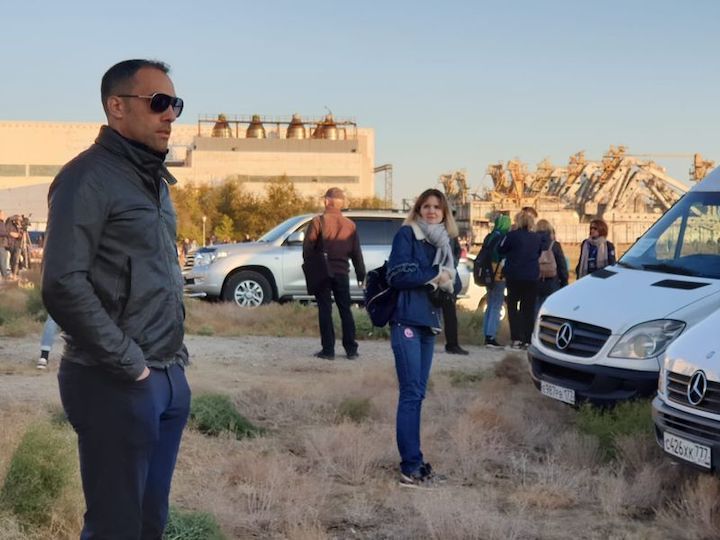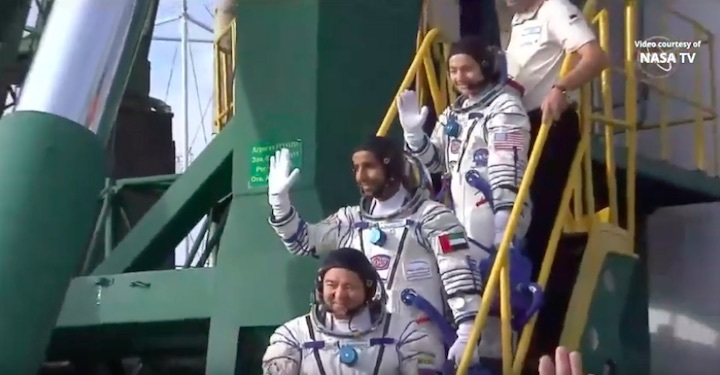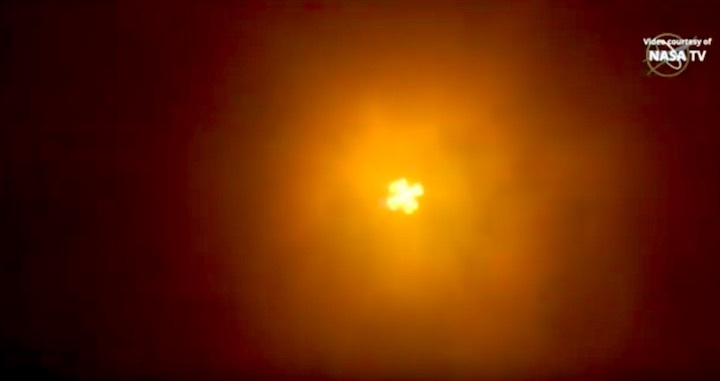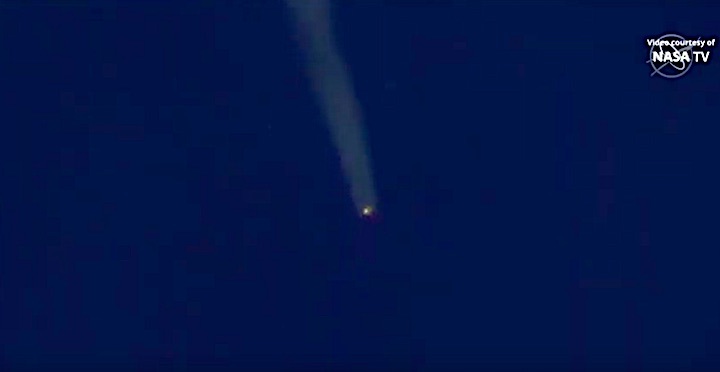16.09.2019


Expedition 61 crewmembers Oleg Skripochka of Roscosmos (left) and Jessica Meir of NASA (right) share some thoughts Sept. 11 during a portion of the initial fit check for their Soyuz MS-15 spacecraft.

Spaceflight participant Hazzaa Ali Almansoori of the United Arab Emirates (left) and Expedition 61 crewmates Oleg Skripochka of Roscosmos (center) and Jessica Meir of NASA (right) pose for pictures Sept. 11 in front of their Soyuz MS-15 spacecraft.

Expedition 61 crewmember Jessica Meir of NASA runs through procedures Sept. 11 aboard the Soyuz MS-15 spacecraft during an initial Soyuz vehicle fit check in the Integration Building at the Baikonur Cosmodrome in Kazakhstan.

Expedition 61 crewmembers Oleg Skripochka of Roscosmos (left) and Jessica Meir of NASA (center) and spaceflight participant Hazzaa Ali Almansoori of the United Arab Emirates pose for pictures with their Russian Sokol launch and entry suits.

The prime and backup crewmembers for the next launch to the International Space Station attend flag-raising ceremonies at their Cosmonaut Hotel crew quarters in Baikonur, Kazakhstan.

The prime and backup crewmembers for the next launch to the space station during flag-raising ceremonies
The prime and backup crewmembers for the next launch to the International Space Station raise the flags of Russia, the United States, the United Arab Emirates and Kazakhstan Sept. 12 in a traditional ceremony.

Sultan Al-Neyadi, Sergey Ryzhikov and Tom Marshburn pose for pictures in front of the Soyuz MS-15 spacecraft
Backup spaceflight participant Sultan Al-Neyadi of the United Arab Emirates (left) and backup Expedition 61 crewmates Sergey Ryzhikov of Roscosmos (center) and Tom Marshburn of NASA (right) pose for pictures Sept. 11 in front of the Soyuz MS-15 spacecraft.
The backup crewmembers for the next launch to the space station discuss the workings of a Soyuz launch pad

jsc2019e052907 - At the Baikonur Museum in the town of Baikonur, Kazakhstan, the backup crewmembers for the next launch to the International Space Station discuss the workings of a Soyuz launch pad Sept. 12 with a museum official during a traditional pre-launch tour. Spaceflight participant Sultan Al-Neyadi of the United Arab Emirates (left), Tom Marshburn of NASA (center) and Sergey Ryzhikov of Roscosmos (right) are the backups to the prime Expedition 61 crew, Oleg Skripochka of Roscosmos and Jessica Meir of NASA and spaceflight participant Hazzaa Ali Almansoori of the United Arab Emirates, who will launch Sept. 25 on the Soyuz MS-15 spacecraft for a mission on the International Space Station. Image: NASA/Victor Zelentsov.
Russia’s carrier rocket with Soyuz MS-15 manned spacecraft installed at Baikonur spaceport
A Soyuz-FG carrier rocket that will launch Soyuz MS-15 manned spacecraft into orbit on September 25 with three crew members onboard has been installed at the launch pad of the Baikonur space center in Kazakhstan, Russia’s space corporation Roscosmos told TASS on Monday.
"In accordance with the decision of the state commission, a Soyuz-FG carrier rocket with the manned spacecraft Soyuz MS-15 has been transported from the assembly and testing facility and installed at the launch pad," the state corporation said.
The Soyuz-FG carrier rocket with the Soyuz MS-15 manned spacecraft is set to blast off at 16:57 Moscow time on September 25 from Baikonur’s famous launch site 1, known as Gagarin’s Start. It will be the 70th and last launch of the Soyuz-FG rocket. In the future, all manned Soyuz spacecraft will be taken into orbit by Soyuz-2.1a carrier rockets.
The Soyuz MS-15 crew will include Russian cosmonaut and mission commander Oleg Skripochka, NASA astronaut Jessica Meir and the UAE’s first astronaut Hazza Al Mansouri. The docking is scheduled for 22:45 Moscow time. Skripochka and Meir will spend 187 days aboard the ISS. Hazza Al Mansouri will return to Earth on October 3, 2019, together with Russian cosmonaut Alexei Ovchinin and US astronaut Nick Hague.
Currently the ISS has a crew of six: Russia’s Alexei Ovchinin and Alexander Skvortsov, NASA’s Nick Hague, Andrew Morgan and Christina Koch and the European Space Agency’s Luca Parmitano (Italy).
Quelle: TASS
+++
Rollout of Soyuz rocket that will take UAE astronaut to space
It's the same launch site where Russian cosmonaut Gagarin blasted off to space in 1961

Hazza Al Mansouri
Baikonur, Kazakhstan: The Soyuz launch vehicle that will transport the UAE’s first astronaut Hazzaa AlMansoori to the International Space Station (ISS) on Wednesday, September 25, has been lifted by a crane to position, ready for launch
Checks will be done and it will then be fuelled up. Earlier on Monday, the Soyuz rocket was rolled out on a rail car.






Service tower lifted up and secured around the rocket.
10.25am local time (9.25 am UAE)
The crane has now come down, and the powerbelt is securely holding the Soyuz MS-15
9.45 am local (8.15am UAE)
The first phase of the installation took 10 minutes, in which it is lifted into position.

Rocket reaches launch pad. It was moved from an assembly building in Baikonur Cosmodrome to launch pad No. 1.
6.46am (5.46 am UAE)
Soyuz rocket rolls out of assembly building.
This is the 144th flight of the Soyuz spacecraft and it will transport the three members of Expedition 61 to the International Space Station.
It was moved from an assembly building in Baikonur Cosmodrome to launch pad No. 1.

Baikonur Cosmodrome launch pad No. 1 is the same launch site where Russian cosmonaut Yuri Gagarin blasted off to space onboard the Vostok 1 spacecraft, becoming the first man in space on April 12, 1961.
Officials, members of the media, and crowds gathered outside the assembly building before sunrise to witness the roll out.
As per tradition since the first rollout in the 1960s, the Soyuz rocket is being rolled out shortly after sunrise.
Salem Al Merri, Assistant Director General of the Mohammed Bin Rashid Space Centre, said: “We’re excited about the launch. They (cosmonaut and astronauts) are in great condition. A meeting was held for minor adjustments in the schedule. But so far, it’s all systems go.”

Flight plans
In command of the Soyuz spacecraft on the Wednesday flight is Russian commander Oleg Skripochka.
Nasa astronaut Jessica Meir is Flight Engineer 1 while Hazzaa will be Flight Engineer 2.
Reliable vehicle
The Soyuz-FG rocket and the Soyuz MS crew vehicle are Roscosmos’ veteran launchers.
They are the longest operating spacecraft programme in the history of space exploration.
Since 2011, the Soyuz rocket family has been the only system capable of sending humans to the ISS since the US’ Space Shuttle Programme was shut down.
The 50-metre-long Soyuz rocket is roughly the height of a 13-storey commercial building. It has a liftoff mass of between 310 and 313 tonnes.
Launch and flight sequence
- The first stage of the rocket is its central block — plus the four boosters.
- Upon ignition, this provides the most powerful thrust on lift-off and once the fuel is consumed, the first stage will be cut off and will separate from the rocket.
- The nose fairing of the rocket will also separate to expose the Soyuz spacecraft sitting on top of the rocket.
- The second stage will then provide the power and lift following which it will be jettisoned and the third stage will continue powering up to space.
- Once the third stage has used up its fuel, it will separate from the spacecraft and the solar arrays will be deployed at roughly 8min and 49 seconds after lift-off.
The nose fairing of the rocket will also separate to expose the Soyuz spacecraft sitting on top of the rocket.
The second stage will then provide the power and lift following which it will be jettisoned and the third stage will continue powering up to space.
Once the third stage has used up its fuel, it will separate from the spacecraft and the solar arrays will be deployed at roughly 8min and 49 seconds after lift-off.
The chase begins
Then the “chase” begins.
The Soyuz spacecraft will fly to the direction of the ISS and will rendezvous with the orbital lab in approximately six hours.
Docking will take place at around midnight in the UAE. The hatch will be opened after two hours — following a procedure to make sure that there are no leaks or pressure differences.
Once the hatch opens, the new crew members will be welcomed to the ISS.
Quelle: GULF NEWS
----
Update: 24.09.2019
.
A multinational crew, including NASA astronaut Jessica Meirand the first space traveler from the United Arab Emirates (UAE), is scheduled to launch to the International Space Station Wednesday, Sept. 25. NASA Television and the agency’s website will provide live coverage of the crew’s launch and arrival.
Meir, Oleg Skripochka of the Russian space agency Roscosmos, and Hazzaa Ali Almansoori from the UAE are set to launch at 9:57 a.m. EDT (6:57 p.m. Kazakhstan time) from the Baikonur Cosmodrome in Kazakhstan aboard the Soyuz MS-15 spacecraft.
The four-orbit, six-hour journey will be the third spaceflight for Skripochka and the first for Meir and Almansoori. Almansoori is flying on an eight-day mission as a spaceflight participant under a contract between the UAE and Roscosmos.
The new crew members will dock to the station’s Zvezda service module at 3:45 p.m.
About two hours after docking, hatches between the Soyuz and the station will open and the new residents will be greeted by station commander Alexey Ovchinin of Roscosmos, NASA astronauts Christina Koch, Nick Hague and Andrew Morgan, ESA (European Space Agency) astronaut Luca Parmitano, and Roscosmos cosmonaut Alexander Skvortsov.
Their arrival will increase the orbiting laboratory’s population to nine people until Oct. 3, when Hague and Ovchinin, who are completing a mission of more than 200 days, will return to Earth with Almansoori on the Soyuz MS-12 spacecraft. Meir and Skripochka will spend more than six months on the station.
Coverage of launch and docking activities is as follows (all times EDT):
- 9 a.m. – Soyuz MS-15 launch coverage
- 3 p.m. – Docking coverage
- 5 p.m. – Hatch opening and welcome coverage
The crew will continue work on hundreds of experiments in biology, biotechnology, physical science and Earth science aboard humanity’s only permanently occupied microgravity laboratory.
Quelle: NASA
----
Update: 25.09.2019
.
Erfolgreicher Start von ISS-Crew-61 mit Soyuz MS-15 spacecraft


























































Quelle: NASA TV

